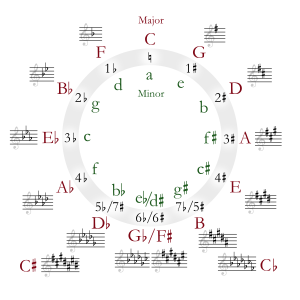| Relative key | G-flat major |
|---|---|
| Parallel key | E-flat major |
| Dominant key | B-flat minor |
| Subdominant | A-flat minor |
| Enharmonic | D-sharp minor |
| Component pitches | |
| E♭, F, G♭, A♭, B♭, C♭, D♭ | |
E-flat minor is a minor scale based on E♭, consisting of the pitches E♭, F, G♭, A♭, B♭, C♭, and D♭. Its key signature consists of six flats. Its relative key is G-flat major (or enharmonically F-sharp major) and its parallel key is E-flat major. Its enharmonic equivalent, D-sharp minor, contains the same number of sharps.
The E-flat natural minor scale is:
Changes needed for the melodic and harmonic versions of the scale are written in with accidentals as necessary. The E-flat harmonic minor and melodic minor scales are:
Scale degree chords
The scale degree chords of E-flat minor are:
- Tonic – E-flat minor
- Supertonic – F diminished
- Mediant – G-flat major
- Subdominant – A-flat minor
- 'Dominant – B-flat minor
- Submediant – C-flat major
- Subtonic – D-flat major
Music in E-flat minor
See also: List of symphonies in E-flat minorIn the 24 canonic keys, most of the composers preferred E-flat minor, while Johann Sebastian Bach, Sergei Lyapunov, and Manuel Ponce preferred D-sharp minor.
In Book 1 of The Well-Tempered Clavier by Bach, Prelude No. 8 is written in E-flat minor while the following fugue is written in D-sharp minor. In Book 2, both movements are in D-sharp minor.
Haydn's Piano Trio No. 41, H. XV.31 in two movements, composed in 1794/95, one of the "London Trios", is in E-flat minor.
Beethoven applied E-flat minor to the slow introduction in the sixth (last) movement of his Septet Op. 20 by adding accidentals while bearing the key signature of E-flat major (three flats). The "Introduction" to his oratorio Christ on the Mount of Olives is also in this key, but with the full six-flat signature.
The final piece in Brahms' Klavierstücke, Op. 118, No. 6, is in E-flat minor. The piece, like many pieces in this key, is dark and funereal, being based on the Dies irae chant. Schubert ended his Impromptus No. 2, D. 899, in E-flat minor, the parallel key to its opening E-flat major, and so did Brahms in his Rhapsody No. 4, Op. 119. Another impromptu by Schubert in this key is the first from D. 946. His march No. 5 from 6 Grandes marches, D. 819 is likwise in E-flat minor. Chopin wrote his Etude No.6, Op. 10, his Polonaise No. 2, Op. 26, and his Prelude No. 14, Op. 28 in E-flat minor.
Tchaikovsky's 1812 Overture is a sonata form in E-flat minor framed by an extended introduction and a long coda, both in E-flat major.
Janáček's Piano Sonata, 1. X. 1905, arguably his best-known work for the piano, is in E-flat minor.
Earlier piano sonatas in the key are the Grand Sonata, Op. 3/1 by George Pinto and the Piano Sonata by Paul Dukas.
Alkan composed the final movement for Symphony for Solo Piano in E-flat minor, as well as the final etude from his Trois morceaux dans le genre pathétique.
The slow movement from the Clarinet Sonata Op. 167 by Camille Saint-Saëns is in E-flat minor.
Prokofiev's Symphony No. 6 opens in E-flat minor but does not return to this key. A few other less well-known composers also wrote symphonies in this key, such as Andrei Eshpai, Jānis Ivanovs (fourth symphony Sinfonia Atlantida, 1941), Ovchinnikov and Nikolai Myaskovsky. Aram Khachaturian wrote his Toccata in E-flat minor while studying under Myaskovsky.
E-flat minor is the key in which Shostakovich composed his fifteenth and final string quartet.
Rachmaninoff's Elegie, Op. 3, No. 1, from Cinq Morceaux de Fantaisie, is in E-flat minor, as is his Étude-Tableau, Op. 39, No. 5.
In Stravinsky's Firebird Suite, most of the Berceuse is in E-flat minor, except for the final measures that lead into the Finale.
The waltz "On the Hills of Manchuria" by Ilya Shatrov, about the loss of Russia in the Russo-Japanese War, is written in E-flat minor. As mentioned, E-flat minor is common in Russian pieces. "On the Hills of Manchuria" is perhaps the most notable example.
Guitarist Yngwie Malmsteen has composed a number of pieces in E-flat minor, including the Concerto Suite for Electric Guitar and Orchestra.
The jazz composition "Take Five" is also in this key.
See also
References
- "Piano Trio in E-flat minor, Hob XV:31 (Haydn) – from CDA67757 – Hyperion Records – MP3 and Lossless downloads". www.hyperion-records.co.uk. Retrieved 2018-02-26.
- "Take Five" sheetmusic, musicnotes.com
Further reading
- Morris, Anthony (March 2006). "Symphonies, Numbers and Keys" (PDF). Bob's Poetry Magazine. III (3). Archived from the original (PDF) on 28 September 2007.
External links
 Media related to E-flat minor at Wikimedia Commons
Media related to E-flat minor at Wikimedia Commons
| Diatonic scales and keys | |||||||||||||||||||||||||||||||||||||||||||||||||||||||||||
|---|---|---|---|---|---|---|---|---|---|---|---|---|---|---|---|---|---|---|---|---|---|---|---|---|---|---|---|---|---|---|---|---|---|---|---|---|---|---|---|---|---|---|---|---|---|---|---|---|---|---|---|---|---|---|---|---|---|---|---|
| |||||||||||||||||||||||||||||||||||||||||||||||||||||||||||




